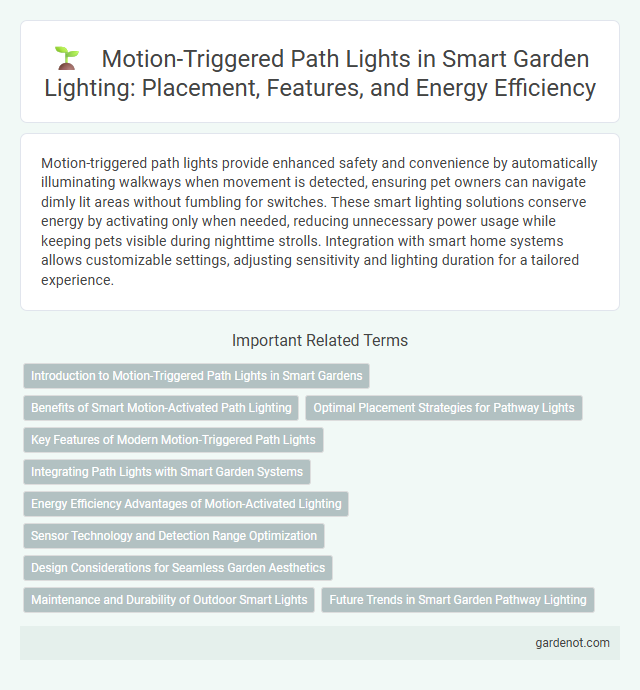Motion-triggered path lights provide enhanced safety and convenience by automatically illuminating walkways when movement is detected, ensuring pet owners can navigate dimly lit areas without fumbling for switches. These smart lighting solutions conserve energy by activating only when needed, reducing unnecessary power usage while keeping pets visible during nighttime strolls. Integration with smart home systems allows customizable settings, adjusting sensitivity and lighting duration for a tailored experience.
Introduction to Motion-Triggered Path Lights in Smart Gardens
Motion-triggered path lights enhance smart gardens by illuminating walkways only when movement is detected, improving both safety and energy efficiency. These lights use advanced sensors to detect motion, automatically activating to provide targeted lighting and turning off after a set period of inactivity. Integrating with smart home systems, motion-triggered path lights offer customizable settings for brightness, sensitivity, and timing, optimizing outdoor illumination based on real-time activity.
Benefits of Smart Motion-Activated Path Lighting
Smart motion-activated path lighting enhances home security by instantly illuminating walkways when movement is detected, deterring potential intruders. These energy-efficient lights reduce electricity consumption by activating only when needed, providing sustainable outdoor illumination. Automated activation improves nighttime visibility and safety, preventing accidents and guiding visitors along paths effortlessly.
Optimal Placement Strategies for Pathway Lights
Optimal placement of motion-triggered path lights enhances both safety and energy efficiency by ensuring coverage along walkways without excessive overlap or dark spots. Positioning lights at regular intervals of 6 to 8 feet along the pathway maximizes sensor activation and illumination, adapting placement to landscape features and potential obstructions. Installing lights at a height of 3 to 4 feet improves sensor range and reduces false activations, creating a balanced lighting environment that responds promptly to movement.
Key Features of Modern Motion-Triggered Path Lights
Modern motion-triggered path lights feature high-sensitivity infrared sensors that detect movement within a specific range, enhancing security and energy efficiency. LED technology provides bright, long-lasting illumination with low power consumption, while smart connectivity options allow integration with home automation systems for customized lighting schedules. Weatherproof designs ensure durability in various outdoor conditions, making these lights reliable for year-round use.
Integrating Path Lights with Smart Garden Systems
Integrating motion-triggered path lights with smart garden systems enhances security and energy efficiency by activating illumination only when movement is detected, reducing unnecessary power consumption. These smart path lights can synchronize with irrigation and weather monitoring systems to adjust brightness based on ambient conditions and outdoor activities. Advanced integration also allows remote control and automation via smartphone apps, optimizing garden aesthetics and safety through real-time data and user preferences.
Energy Efficiency Advantages of Motion-Activated Lighting
Motion-triggered path lights enhance energy efficiency by illuminating only when movement is detected, significantly reducing unnecessary power consumption compared to continuous lighting systems. These smart lighting solutions leverage advanced sensors to activate illumination precisely in occupied areas, optimizing energy use and extending bulb lifespan. Incorporating motion-activated lighting in outdoor pathways contributes to sustainable energy practices while maintaining safety and convenience.
Sensor Technology and Detection Range Optimization
Motion-triggered path lights utilize advanced passive infrared (PIR) sensors that detect heat signatures and movement to activate lighting instantly. Optimization of detection range involves calibrating sensor sensitivity and angle to ensure precise activation within 10 to 30 feet, minimizing false triggers from environmental factors. Incorporating dual-sensor systems enhances accuracy by combining PIR with microwave radar technology for reliable motion detection in diverse outdoor conditions.
Design Considerations for Seamless Garden Aesthetics
Motion-triggered path lights should blend with garden elements through materials like frosted glass, brushed metal, or natural wood finishes to maintain a cohesive look. Opt for low-profile fixtures with adjustable brightness and warm color temperatures that complement surrounding plants and pathways. Integrating sensor placement subtly within landscape features ensures illumination activates without disrupting the garden's visual harmony.
Maintenance and Durability of Outdoor Smart Lights
Motion-triggered path lights designed for outdoor use feature durable, weather-resistant materials such as anodized aluminum and tempered glass to withstand harsh environmental conditions. These smart lights incorporate low-maintenance LED technology with long lifespans exceeding 50,000 hours, reducing the need for frequent replacements. Advanced sealed housings prevent moisture and dust ingress, ensuring consistent performance and minimal upkeep in varied outdoor settings.
Future Trends in Smart Garden Pathway Lighting
Motion-triggered path lights are evolving with AI integration, enabling adaptive brightness and pattern recognition to enhance energy efficiency and security. Future smart garden pathway lighting will leverage IoT connectivity for remote customization and real-time environmental responsiveness. Advancements in solar-powered LEDs and sensor technology will further reduce energy consumption while improving illumination precision.
Motion-triggered path light Infographic

 gardenot.com
gardenot.com